Odd Numbers
Odd numbers are integers that are not divisible by 2. In other words, when an odd number is divided by 2, there is always a remainder of 1. The set of odd numbers includes the numbers 1, 3, 5, 7, 9, and so on.
Properties of Odd Numbers:
- Every odd number can be represented in the form 2n + 1, where n is an integer.
- The sum of two odd numbers is always an even number.
- The difference between two odd numbers is always an even number.
- Multiplying two odd numbers always results in another odd number.
Identifying Odd Numbers:
To determine if a number is odd, divide it by 2. If there is a remainder of 1, the number is odd. For example, when 11 is divided by 2, the quotient is 5 with a remainder of 1, so 11 is an odd number.
Practice Problems:
- Determine whether the following numbers are odd or even: 16, 25, 37, 42, 53.
- Find the sum of the first 5 odd numbers.
- If x is an odd number, what can you say about the value of 2x?
Answers:
- 16 is even, 25 is odd, 37 is odd, 42 is even, 53 is odd.
- The first 5 odd numbers are 1, 3, 5, 7, 9. Their sum is 25.
- 2x is always even, because multiplying any number by 2 results in an even number.
Now that you understand the concept of odd numbers, try solving more problems and practice identifying odd numbers in different sets of integers.
.◂Math Worksheets and Study Guides Sixth Grade. Division
Study Guide Division
Division  Worksheet/Answer key
Worksheet/Answer key Division
Division  Worksheet/Answer key
Worksheet/Answer key Division
Division  Worksheet/Answer key
Worksheet/Answer key Division
Division 

 Worksheet/Answer key
Worksheet/Answer key
 Worksheet/Answer key
Worksheet/Answer key
 Worksheet/Answer key
Worksheet/Answer key

The resources above cover the following skills:
Connections to the Grade 6 Focal Points (NCTM)
Number and Operations: Students' work in dividing fractions shows them that they can express the result of dividing two whole numbers as a fraction (viewed as parts of a whole). Students then extend their work in grade 5 with division of whole numbers to give mixed number and decimal solutions to division problems with whole numbers. They recognize that ratio tables not only derive from rows in the multiplication table but also connect with equivalent fractions. Students distinguish multiplicative comparisons from additive comparisons.